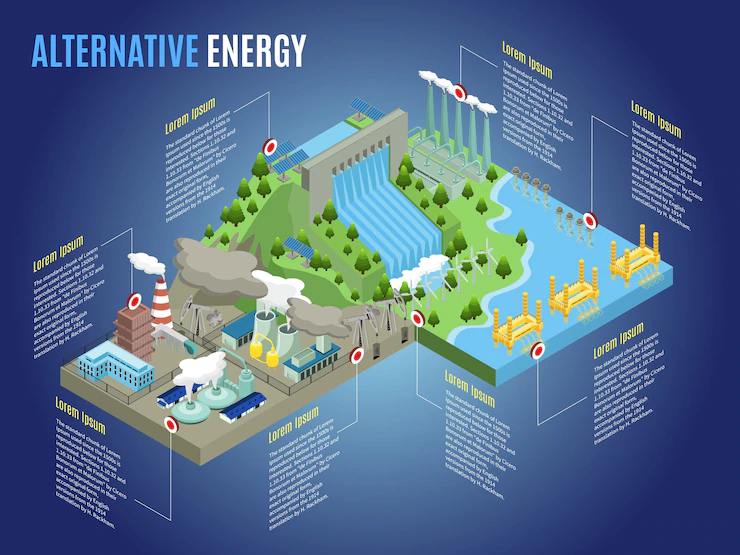Hydropower


Hydropower :, also known as water power, is the use of falling or fast-running water to produce electricity or to power machines. This is achieved by converting the gravitational potential or kinetic energy of a water source to produce power.Hydropower is a method of sustainable energy production. Hydropower is now used principally for hydroelectric power generation, and is also applied as one half of an energy storage system known as pumped-storage hydroelectricity.
Hydropower is an attractive alternative to fossil fuels as it does not directly produce carbon dioxide or other atmospheric pollutants and it provides a relatively consistent source of power. Nonetheless, it has economic, sociological, and environmental downsides and requires a sufficiently energetic source of water, such as a river or elevated lake.International institutions such as the World Bank view hydropower as a low-carbon means for economic development. Since ancient times, hydropower from watermills has been used as a renewable energy source for irrigation and the operation of mechanical devices, such as gristmills, sawmills, textile mills, trip hammers, dock cranes, domestic lifts, and ore mills. A trompe, which produces compressed air from falling water, is sometimes used to power other machinery at a distance.
Technological advances moved the open water wheel into an enclosed turbine or water motor. In 1848, the British-American engineer James B. Francis, head engineer of Lowell's Locks and Canals company, improved on these designs to create a turbine with 90% efficiency.He applied scientific principles and testing methods to the problem of turbine design. His mathematical and graphical calculation methods allowed the confident design of high-efficiency turbines to exactly match a site's specific flow conditions. The Francis reaction turbine is still in use. In the 1870s, deriving from uses in the California mining industry, Lester Allan Pelton developed the high-efficiency Pelton wheel impulse turbine, which used hydropower from the high head streams characteristic of the Sierra Nevada
Some disadvantages of hydropower have been identified. Dam failures can have catastrophic effects, including loss of life, property and pollution of land.
Dams and reservoirs can have major negative impacts on river ecosystems such as preventing some animals traveling upstream, cooling and de-oxygenating of water released downstream, and loss of nutrients due to settling of particulates.River sediment builds river deltas and dams prevent them from restoring what is lost from erosion.Furthermore, studies found that the construction of dams and reservoirs can result in habitat loss for some aquatic species.
Large and deep dam and reservoir plants cover large areas of land which causes greenhouse gas emissions from underwater rotting vegetation. Furthermore, although at lower levels than other renewable energy sources, it was found that hydropower produces methane gas which is a greenhouse gas. This occurs when organic matters accumulate at the bottom of the reservoir because of the deoxygenation of water which triggers anaerobic digestion.
People who live near a hydro plant site are displaced during construction or when reservoir banks become unstable.Another potential disadvantage is cultural or religious sites may block construction
Rain power Rain has been referred to as "one of the last unexploited energy sources in nature. When it rains, billions of litres of water can fall, which have enormous electric potential if used in the right way."Research is being done into the different methods of generating power from rain, such as by using the energy in the impact of raindrops. This is in its very early stages with new and emerging technologies being tested, prototyped and created. Such power has been called rain power.One method in which this has been attempted is by using hybrid solar panels called "all-weather solar panels" that can generate electricity from both the sun and the rain.[21] According to zoologist and science and technology educator, Luis Villazon, "A 2008 French study estimated that you could use piezoelectric devices, which generate power when they move, to extract 12 milliwatts from a raindrop. Over a year, this would amount to less than 0.001kWh per square metre – enough to power a remote sensor." Villazon suggested a better application would be to collect the water from fallen rain and use it to drive a turbine, with an estimated energy generation of 3 kWh of energy per year for a 185 m2 roof.[22] A microturbine-based system created by three students from the Technological University of Mexico has been used to generate electricity. The Pluvia system "uses the stream of rainwater runoff from houses' rooftop rain gutters to spin a microturbine in a cylindrical housing. Electricity generated by that turbine is used to charge 12-volt batteries. The term rain power has also been applied to hydropower systems which include the process of capturing the rain.